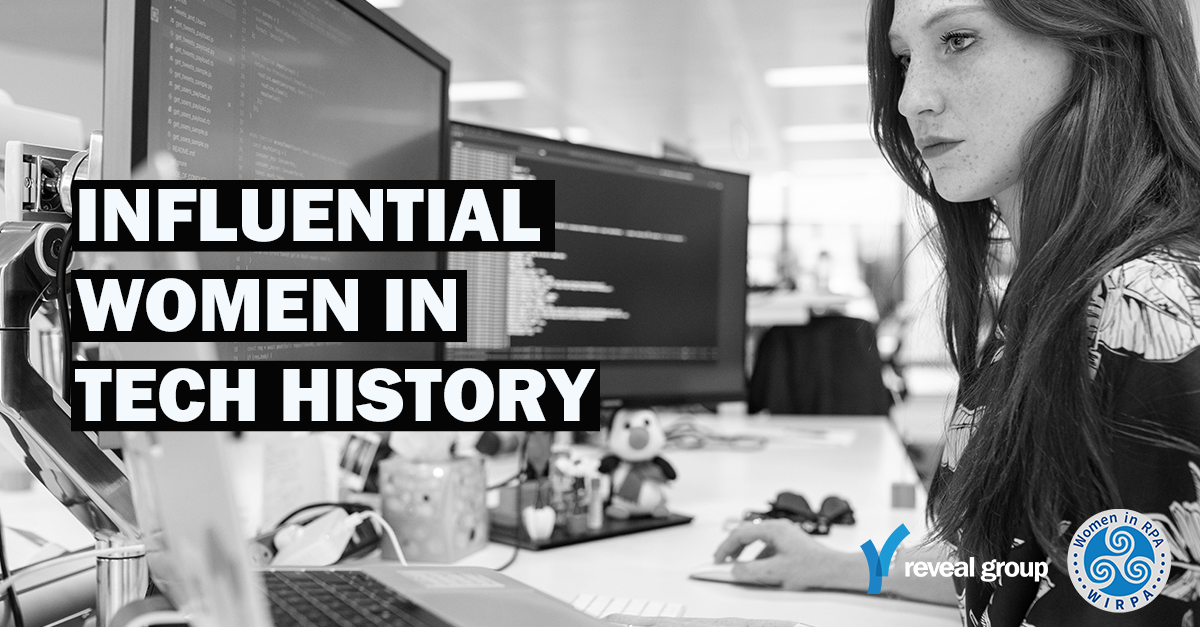
Influential Women in Tech History
In honor of International Women’s Day, we’re highlighting just a few of the rockstars who have taken the digital world by storm. Although “Women in Tech” is celebrated throughout media outlets, with so much content vying for viewers’ attention, these ladies’ triumphs fade into the background. Today is not that day – Let’s meet these fabulous women:

Our first female trail blazer is Ada Lovelace (1815-1852) who was an English mathematician credited with being the first computer programmer. From an early age, Ada had an aptitude for mathematics and was taught math and science by tutors. Around the age of 17, Ada met Charles Babbage, a mathematician and inventor who, at that time, was working on ‘the Difference Engine’, an elaborate calculating machine which used finite differences. Babbage became a mentor for Lovelace and helped facilitate her study of advanced mathematics at the University of London. Babbage shortly after started created plans for another device known as ‘the Analytical Engine’, designed to handle more complex calculations. Lovelace was later asked to translate a French article about the analytical engine written by Italian engineer Luigi Federico Menabrea for a Swiss journal. In translating the article, she added her own thoughts and ideas on the machine. Her notes ended up being three times longer than the original article and were published in an English science journal in 1843, using only her initials, “A.A.L.,” in the publication.
In her notes, Lovelace shows how codes could be created for the device to handle letters and symbols in addition to numbers. She theorized a method for the engine to repeat a series of instructions (a process now known as looping). Ada’s notes included the first published description of a stepwise sequence of operations for solving certain mathematical problems, granting her the title of the first computer programmer.

Up next is the Dr. Grete Hermann (1901-1984) was a German mathematician, philosopher, physicist, and activist. Her thesis, ‘The Question of Finitely Many Steps in Polynomial Ideal Theory’(1926) has been described as the foundational paper for computer algebra. At that time, mathematicians appear to have been largely unfamiliar with not only the concept of computers but even our contemporary concept of an algorithm, despite the prevalence of computational mathematics. Hermann’s paper presents the first examples of procedures, with upper bounds given, for a variety of computations in multivariate polynomial ideals.
Her thesis first established the existence of algorithms (including complexity bounds) for many or the problems of abstract algebra.
At that time Hermann was completing her doctoral studies in mathematics, quantum mechanics was on the horizon. Attempts to understand the new and complex way of looking at the physical world (vs Newtonian physics) were of great contemporary importance when Hermann entered the field. Her main work in physics was related to interpreting quantum mechanics, and specifically the philosophical foundations of quantum mechanics, the significance of modern physics for the theory of knowledge, and causality in physics. She was one of the active early contributors to the historic debates on causality in quantum mechanics, and on the completeness of quantum mechanics and its description of reality.
Hermann stopped researching during WWII and was a political refugee from Hitler for being an anti-nazi activist. After the war, she became a teacher.

The noble and ever resilient, Admiral Dr. Grace Hopper (1906-1992) was an American mathematician and rear admiral in the U.S. Navy. She was a computer pioneer, best known for her trailblazing contributions to the development of computer languages, and one of the first three modern “programmers”.
Hopper was involved in the creation of the Mark I, an early prototype of the electronic computer. She was responsible programming the Mark I, punching machine instructions onto tape, and writing a 561-page user manual for the Mark I in which she outlined fundamental operating principles of computing machines. One evening in 1945, while working on the Mark II, she & her colleagues encountered a problem. They took the machine apart and found a large moth. Although the term “bug” had been used by engineers since the 19th century to describe a mechanical malfunction, Hopper was the first to refer to a computer problem as a “bug” and to speak of “debugging” a computer.
As head programmer for Remington Rand, she worked on the UNIVAC I (Universal Automatic Computer). In 1952 her programming team developed the first computer language “compiler” called A-0. Compilers translate mathematical code into machine-readable binary code & they would eventually make it possible to write programs for multiple computers rather than a single machine. Next, her team developed Flow-Matic, the first programming language to use English-like commands. Unlike earlier computer languages like FORTRAN, which used mathematical symbols, Flow-Matic used regular English words so that data processors (who were not typically mathematicians or engineers) would feel more comfortable using word-based languages. In 1959, Common Business-Oriented Language or better known as COBOL was introduced as the first standardized general business computer language. At the age of 79, Hopper retired as a rear admiral as the oldest serving officer in the U.S. Armed Forces.

A force to be reckoned with, Hanna Wallach is a computational social scientist and partner research manager at Microsoft Research. Her work is important to all of us because it makes use of machine learning models to study the dynamics of social processes. In her early research stages, she wanted to look at the development of natural language processing which analyses the structure and content of social processes. So in 2007, she joined the University of Massachusetts Amherst and was made Assistant Professor in 2010. She worked alongside journalists and computer scientists to better understand how organizations function. Wallach explained that social interactions have several things in common; structure (i.e. who is involved in the interaction), content (the information that is shared during or arises from these interactions) and dynamics (the structure and content can change over time).
Now at Microsoft Research, her current research focuses on issues of fairness, accountability, transparency, and ethics as they relate to AI and machine learning. In 2020 she worked with machine learning practitioners from across the tech sector to create an artificial intelligence ethics checklist. The checklist aimed to provide clear guidelines for the ethical development of artificial intelligence systems.
Her discoveries and findings have absolutely not gone un-noticed- she’s won numerous awards over the years including Glamour Magazine’s 35 Women Under 35 Who Are Changing the Tech Industry (2014), International Machine Learning Society’s Board of Trustees (2015), and most recently was nominated Chair of the Conference on Neural Information Processing Systems (2019).
Some really cool facts that are lesser known about this rockstar is that she’s a competitive roller derby player! She’s an advocate for the improved representation of women working in computer science, plus she was co-founder of the now annual Women in Machine Learning Workshop, Debian Women Project, and GNOME Outreach Program for Women (now known as Outreachy).

Joy Buolamwini is a Ghanaian-American-Canadian computer scientist and digital activist based at the MIT Media Lab. She founded the Algorithmic Justice League, an organization that looks to challenge bias in decision-making software. The organization does this by blending art, advocacy, and research to highlight the social implications and harms of AI.
She is a researcher at the MIT Media Lab, where she identifies bias in algorithms and develops practices for accountability during their design; at the lab, Buolamwini is a member of Ethan Zuckerman’s Center for Civic Media group. During her research, Buolamwini showed facial recognition systems 1,000 faces and asked them to identify whether faces were female or male, she found that software found it hard to identify dark-skinned women. Her project, Gender Shades, has attracted significant media attention and become part of her MIT thesis. Her 2018 paper Gender Shades: Intersectional Accuracy Disparities in Commercial Gender Classification, prompted responses from IBM and Microsoft, who swiftly improved their software. She also created the Aspire Mirror, a device that lets you see a reflection of yourself based on what inspires you.
Joy founded the Algorithmic Justice League (AJL) in 2016 to lead the charge in acquiring equitable and accountable artificial intelligence (AI). The AJL organization combines art and research to illuminate the societal implications and harms of AI. The company’s mission is to raise public awareness about the impacts of AI, equip society with research, give a voice to the most vulnerable communities, and galvanize the tech industry and congress. Her program aims to highlight the bias in code that can lead to discrimination against underrepresented groups. She has created two films, ‘Code4Rights’ and ‘Algorithmic Justice League: Unmasking Bias’. She is Chief Technology Officer for Techturized Inc, a haircare technology company. Buolamwini’s research is cited as an influence for Google and Microsoft in addressing gender and race bias in their products and processes.
She’s slowly being recognized in the public eye for you ground-breaking discoveries; she was awarded the grand prize in the professional category in the Search for Hidden Figures contest, tied to the release of the film Hidden Figures in December 2016. The contest was intended to “help uncover the next generation of female leaders in science, technology, engineering and math,” and attracted 7,300 submissions from young women across the United States.
She’s also been on Amy Poehler’s Smart Girls in 2018 and delivered a TEDx talk at Beacon Street entitled How I’m fighting bias in algorithms (How I’m fighting bias in algorithms | Joy Buolamwini – YouTube).
Buolamwini was also listed in Fortune Magazine’s 2019 list of the World’s Greatest Leaders. The magazine also termed her “the conscience of the A.I. revolution”. She also made the inaugural Time 100 Next list in 2019.
